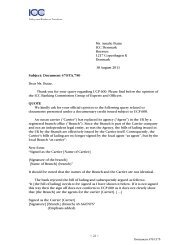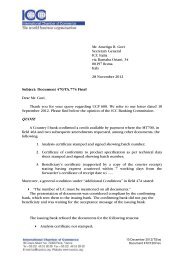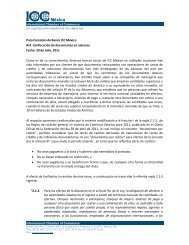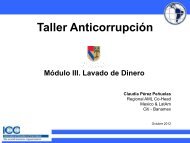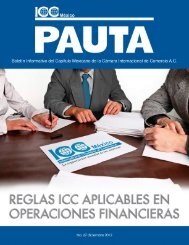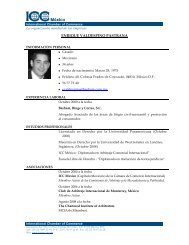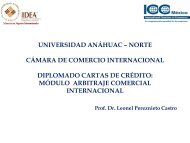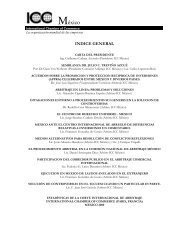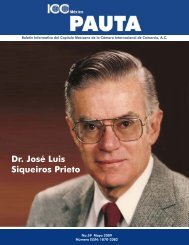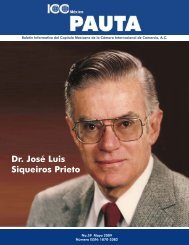Pauta 54.pdf - ICC México
Pauta 54.pdf - ICC México
Pauta 54.pdf - ICC México
- No tags were found...
Create successful ePaper yourself
Turn your PDF publications into a flip-book with our unique Google optimized e-Paper software.
Final Report on ConstructionIndustry ArbittrationsPoints at Issue33. We have already said that if true issues have not been precisely determined the first objective should be toestablish them. The tribunal should draw up issues in the sense of points requiring decision at the conclusion ofthe first procedural meeting. Thereafter as the case proceeds the tribunal should revise and reissue the list inconsultation with the parties for the purposes, for example, of guiding the parties as to the topics that must becovered in their written submissions and at any hearing, as well as to ensure that the tribunal is clear in its ownmind about the points that it will have to decide and why they need to be dealt with in the award.34. Where the disputes emanate from a contractual dispute resolution procedure or if the parties are apparentlyrepresented by competent lawyers who are familiar with construction disputes or if the amounts in dispute are notlarge there is a strong case for proceeding directly to proof in the sense of requiring the parties to presentsubmissions accompanied by the evidence each considers necessary to establish its case (in the light of what isthen known about the opposing case), both documentary and in the form of attested statements from witnesses.Unless the arbitration is to be of the “fast-track” type these submissions should not be submitted simultaneouslybut consecutively, with the claimant presenting its case first so that defendant can reply to it. The timetable willtherefore have to be fixed by the tribunal. The tribunal may then permit the parties to submit further submissionsor evidence either of their volition or to meet requests or directions of the tribunal. (All evidence is of course to befurnished to the tribunal and to the other party at the same time.) As a general point any further submissionsshould be numbered or arranged to match the submissions of the other party.35. Once this stage is complete the tribunal may be better able to draw up a list of the issues as they appear to itand to guide the parties as to what is now required.Further Working Documents and Schedules36. Some specialists favour the creation of a working document by exchange between the parties which records quitebriefly the essential elements of each party's case. This is best exemplified by the schedule used in English practicefor typical claims for changes, for disputes about the value of work and for claims for work done improperly ornot at all. Today such a schedule can be created and can travel on disk or by e-mail so it need not becumbersome to handle. In the right hands it is a useful tool. It defines the positions of the parties and ultimately itwill or can be used by the tribunal to record its views and decisions. At the pre-hearing stage its main value isthat, if properly compiled, it establishes the position of each party where the existing submissions or pleadings donot already do so adequately. There is no point in incurring costs in duplicating what is already available, even ifit is not ideal. Parties do not always present their cases neatly on a plate and the tribunal must expect to have toanalyse the material presented to it. Moreover the success of such a document depends in part on each partygrappling and dealing positively with the principal allegations of the other party. For example a defendant wouldbe required to state specifically(a) which of the claimant's allegations are admitted;(b) which of the claimant's allegations are denied (and why they are not accepted);(c) which allegations cannot be admitted or denied (together with a brief explanation of the reason) and whichthe claimant is required to prove.In addition there must be a constructive approach, so if a defendant were to deny an allegation the reasons fordoing so have to be given and if it is intended that there is a different version of events from that given by theclaimant, that version must be stated. Otherwise the claimant and the tribunal will not know the real nature of thedefendant's case. The essential elements of this approach may be seen from a sample extract of a scheduleannexed to this report.37. Where the claim is for numerous changes or variations and the statement of case and defence do not indicatewhere all the differences lie, the tribunal should order the claimant to state how each change came about, thePAUTA 45



